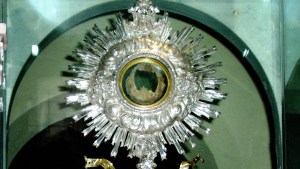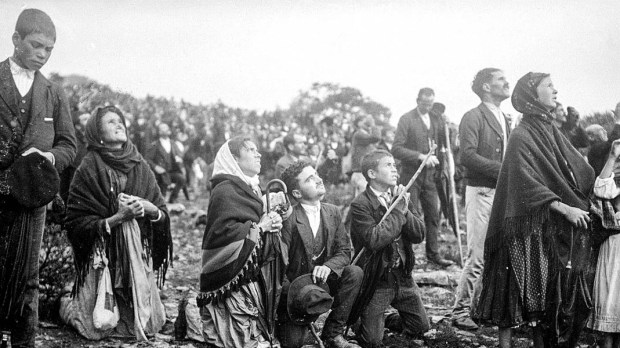“Miracles always relate to the faith. That is why a belief in miracles is not a vacation from reason, a little holiday from the tedious demands of rational responsibility. Not only is it reasonable to believe that miracles can and do happen, it is unreasonable to think they cannot and do not occur.”― Ralph M. McInerny, Miracles—a Catholic View
About a year ago I wrote an article called “Can a scientist believe in miracles?” that drew quite a bit of attention. I had interviews with Catholic radio, a Roman newspaper, and a video (still in progress). Rather than repeating what was said there, I’d like to explore speculations that have been at the back of my physics-trained mind since I wrote that article: How does God do miracles?
As a Catholic, I accept that God is all powerful; He can bend or modify the so-called laws of physics at His pleasure. But I also believe that God likes an orderly universe and does a minimum of tinkering, only as needed. And my curious, prideful intellect wants to understand how God works His ways, even though the Preacher says it is likely to be a fruitless endeavor:
Then I beheld all the work of God, that a man cannot find out the work that is done under the sun: because though a man labor to seek it out, yet he shall not find it; yea further; though a wise man think to know it, yet shall he not be able to find it.
—Ecclesiastes 8:14 (KJV)
Nevertheless, here is my modest attempt.
Before considering two examples that might be susceptible to analysis—the Miracle of the Sun at Fatima and Eucharistic miracles—let’s think about the type of evidence that’s usually presented for miracles.
First, miracles aren’t reproducible; they’re not scientific experiments or observations, but one-time events. So we must depend on testimony, the reports of observers for many miracles. Some miracles—medical cures, Eucharistic miracles, incorrupt bodies, relics (e.g. the Shroud of Turin)—can be subjected to scientific analyses to assist understanding insofar as we may understand.
The second important point is that the Church has rigorous standards for approval of miracles. Should a Church-approved miracle turn out to be due to natural, rather than supernatural causes, or — worse yet — to be the product of fakery, the Church will wind up with egg on her face. The supposed miracle will be cited by nonbelievers as additional evidence against the truth of the theological and moral stances taken by the Church. Accordingly, we should acknowledge that the evidence for a miracle approved by the Church is strong, indeed.
The Miracle of the Sun at Fatima
The three Portuguese children who had a visitation from Our Lady of the Rosary said that she would give a sign to attest to her visitation. And so she did: on October 13, 1917, in the presence of many tens of thousands of believers and nonbelievers, the sun appeared to do strange things: dance up and down, shine with different colors, grow dim. (See here and here for a complete description.) Although these happenings were local, they were reported by observers 11 and 25 miles away, and by Pope Pius XII, walking in his gardens in Italy (disclosed in a later note).
Different phenomena were reported by different observers. Some unbelievers saw strange things and some believers didn’t see anything. What can we make of this? Scientific mechanisms have been offered: for example, Fr. Stanley Jaki proposed an unusual temperature inversion and ice crystal clouds to give the observed effects. Others have proposed mass hallucinations. If we dig beyond the semantics of “hallucination,” we can come to another explanation. The Holy Spirit can come to us and give us a vision; a vision that is real to us, although it would not be recorded by any camera. That’s my humble and best guess at what happened. It is not a violation of natural laws, but it is a “supernatural” event in the fullest sense of the word, just as our soul is a supernatural entity.
Eucharistic miracles
As far back as the 8th century, instances have been reported in which the Eucharistic host has been transformed into human tissue, sometimes with blood present. (See here for one such account). When these transformed hosts are subjected to clinical analysis by certified pathology laboratories, they are found to contain human cardiac tissue (sometimes noted to be under great stress). They also share a common blood type, AB+, what we call the “universal recipient” — appropriate, by the way, for the One “who reconciles all things to himself” through the blood of his cross. (Col. 1:20)
Here are some questions I would pose as a scientist: 1) Is the mass of the transformed host less, the same, or more than that of the original? Looking at a picture of the transformed host in a monstrance, it would seem to be less, so no conservation of mass law is violated.

Read more:
4 Incredible Eucharistic miracles that defy scientific explanation
2) Human DNA has been found in several of the transformed tissues. Is it the same DNA?
One might also inquire about the thermodynamic changes that might have to occur if the matter in the host is transformed into tissue, and where the necessary energy would come from.
Of course it is not necessary that the host show the properties of human tissue. We believe in the Real Presence, that the consecrated host is the Body, Blood, Flesh and Divinity of Our Lord, Jesus Christ. The appearances are “accidents”; the reality, the substance, is the Real Presence. In the words of Tantum Ergo:
“Præstet fides supplementum
Sensuum defectui.”“Let faith provide a remedy for the failure of the senses.”
So should we say that these Eucharistic miracles are signs to help those wavering in faith to believe in the Real Presence—not necessary, but helpful? Perhaps. Scientific validation of what we know by faith is very nice, but not necessary. Faith is “the assurance of things hoped for, the conviction of things not seen.” (Hebrews 11:1)
As the quote from Ecclesiastes used earlier puts it, science doesn’t really have much to say about miracles. They are supernatural, beyond our ken, above and beyond the laws or regularities that we find apply to our everyday world. Even though I have been a practicing physicist, I do believe there is more to the world than can be explained by science. So, I will pour the balm of Psalm 131 on my itch to know what and why:
My heart is not proud, Lord,
my eyes are not haughty;
I do not concern myself with great matters
or things too wonderful for me.
—Psalm 131:1 (KJV)

